Scaffolding: Is it a plank? Or a platform?
15 August 2023
I am continually perplexed by the questions that arise concerning platforms and planks. It appears that it starts with a misunderstanding of what constitutes a platform. For some, a platform is any piece of material that appears of sufficient strength to support the worker who uses it. For others, it is a conceived notion that it must contain certain components, such as “OSHA approved” products.
Fundamentally, a scaffold platform is any temporary surface that supports workers, materials, or both. To be a scaffold, the platform must be temporary and have a supporting structure. In addition, applicable regulations dictate that the platform must meet certain requirements to deem it safe. Once those expectations are met, anything is acceptable, including manufactured planks and decks, sawn wood products, or any combination of components that have sufficient strength. For this discussion, the focus is on solid sawn wood plank.
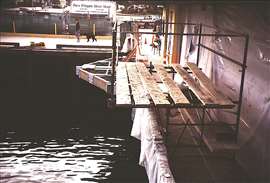 Poorly installed plank. (Photo: David Glabe)
Poorly installed plank. (Photo: David Glabe)
The basics
The most common wood product used for scaffold platforms is solid sawn wood, that is a piece of a tree cut with a saw to certain dimensions. The most common size is a chunk of wood cut to the dimensions of 1-1/2 inches by 9-1/4 inches and is called a nominal 2x10. The term nominal means that the piece of wood is not really 2 inches by 10 inches, but it’s a lot easier to say 2 by 10 than 1 5/8 by 9-1/4, isn’t it? The resulting piece of wood is evaluated by a skilled inspector who, based on the type of tree, the number of rings, knots, and other factors. grades the piece of wood to determine its classification. One of these grades is the scaffold grade, which is the grade commonly used in scaffolding. This piece of wood is commonly called a plank in the scaffold industry. Additionally, the load that a scaffold grade 2x10 plank can support is based on the grade.
It is up to the scaffold erectors and the users to make sure the planks are not overloaded. Scaffold erectors determine the load carrying capacity of the plank when they determine the span of the plank. It is up to the user to make sure that the plank is not overloaded.
Unfortunately, it is much too common for scaffold erectors and users to equate the plank span to capacity without considering other factors. For example, a plank spanning 10 feet is normally recognized to support what is referred to as a light duty load rating, a load of 25 pounds per square foot. While this may be accurate for one plank, it may not be accurate for the entire scaffold. If the scaffold has 10 levels of plank, the scaffold will be overloaded.
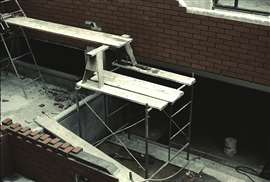 Improper plank use. (Photo: David Glabe)
Improper plank use. (Photo: David Glabe)
Considerations
Other strange things occur with plank platforms. One platform design utilizes plywood on top of wood plank. To avoid lapping the plank, one half-inch thick plywood is laid on top of 2x10 planks that are spaced 10 inches apart, so the finished platform is flat. And here is where the problem for many erectors and users begins. Experience indicates that too many erectors, and self-appointed qualified designers, refuse to educate themselves as to the strength of the platform they are constructing. They think that since the plank spans ten feet, the platform can be rated as a light duty platform, a platform that can support 25 pounds per square foot. But how can this be?
The platform has half the plank as a fully planked platform. Complicating the situation is the insistence by compliance officers and other safety-oriented folks to insist that the 2x10s must be scaffold grade. Nowhere is that required. If 4x4s were used instead of 2x10s, no one would bother to raise any questions. So, what is the difference between a 4x4 and a 2x10 other than that one is bigger than the other. What if the 2x10 is set on edge, that is, vertically rather than on the flat. Would anyone question that?
This brings up the next misconception, where it is assumed that all platforms must support at least a light duty load. Nowhere in the OSHA regulations is this required. What is required is that the platform has a 4-to-1 safety factor.
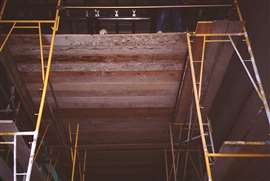 A skip plank platform. (Photo: David Glabe)
A skip plank platform. (Photo: David Glabe)
Here are a few more useful pieces of information regarding the use of 2x10 boards as scaffold platforms:
- A plank is a thick board.
- A 2x10 isn’t a thick board but everyone calls it a plank when it’s used for a scaffold platform.
- OSHA calls planks platform units.
- When 2x10s and plywood are used to make a platform, the 2x10s are joists, not planks or platform units.
- The maximum gap between platform units is 1 inch unless you can show you have to have a bigger gap. Not sure who you have to show it to but it’s reasonable to assume it’s the safety guy questioning your platform unit installation.
- The maximum space between the front edge of the platform and the work surface (the wall for example), before a guard rail is required, is 14 inches, unless you are a stucco guy. Then it is 18 inches. Not sure what happens if you use personal fall protection instead of a guardrail. Of course, if you happen to be in California, the space is 16 inches, apparently an effort to split the 14- and 18-inch requirement.
- The maximum deflection for a plank is 1/60th of the span when loaded---that is when the plank is loaded. As an example, for a ten-foot span, that would be 2 inches.
- The platform must be at least 18 inches wide unless you can show you cannot do that. Then make it as wide as you can and use fall protection.
-
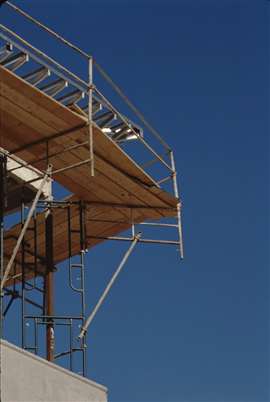 (Photo: David Glabe)
(Photo: David Glabe)
- The platform must extend as fully as possible between the front uprights and the guardrail supports unless you are (surprise) in California. Then the platform must extend between the scaffold uprights. You figure it out.
- Once the gap at the back of the scaffold is 9-1/2 inches, put a plank in there. Except for California, where it’s 10 inches. But then that is the nominal dimension (see above) so it’s the same as the federal requirement of 9-1/2 inches. Wow-they agree!
- California requires that all scaffold planks shall be visually inspected before use each day. Not sure if that is every plank in the U.S. or just California.
- Plank must overhang their supports at least 6 inches but not more than 12 inches for plank 10 feet or less in length (not span but length) and 18 inches for longer plank.
- California says that scaffold plank must be at least 2-inch by 10-inch material; OSHA is silent on the matter.
- OSHA doesn’t approve anything. If the plank has a stamp that says so, it’s bogus.
- Don’t use a scaffold plank as a scaffold sill and then as a platform unit. That would be really stupid.
This isn’t a complete list. Go to OSHA 29 CFR 1926.451 for more information and the various state OSHAs for complete information. States such as California, Michigan, Washington, Oregon, and New York have unique and modified federal OSHA requirements.
Planks are essential components of a scaffold and a scaffold platform. Don’t take chances. Don’t claim to know the plank capacity if you don’t fully understand both the plank and the scaffold capacity. Remember, there is no backup for a plank. If it breaks or slips off its support, down the user will go with the outcome not being good. Do you want to be that person?
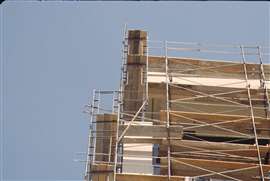 An example of dangerous plank overhangs. (Photo: David Glabe)
An example of dangerous plank overhangs. (Photo: David Glabe)





